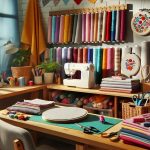When you start sewing with bamboo fabric, you'll quickly appreciate its softness and eco-friendly qualities. To get the most out of your projects, it's crucial to prepare your workspace and choose the right tools. You'll want to ensure your cutting technique is precise to avoid stretching the fabric, which can be tricky for beginners. Plus, mastering the right sewing techniques can make a significant difference in the durability of your creations. But what's the best way to care for your bamboo masterpieces once they're complete? Let's explore that next.
Table of Contents
Key Takeaways
- Prepare your sewing space with organized tools, good lighting, and a comfortable area to enhance focus and creativity while working with bamboo fabric.
- Use sharp scissors or a rotary cutter for clean edges and take care when measuring and cutting to prevent fabric stretching.
- Opt for ballpoint needles and a straight stitch to prevent snags and maintain fabric integrity, adjusting tension as needed for better results.
- Finish edges with techniques like zigzag stitches, French seams, or bias tape to enhance durability and provide a polished look.
Understanding Bamboo Fabric
Understanding bamboo fabric begins with recognizing its unique properties, which make it an eco-friendly and versatile choice for sewing projects. Bamboo fibers are derived from the pulp of the bamboo plant, and they possess natural antibacterial and moisture-wicking qualities. This means your finished garments can help keep you fresh and comfortable, especially in warmer climates or during active wear.
You'll find bamboo fabric incredibly soft, often compared to silk or cashmere, making it a pleasure to wear. Its breathability ensures that it regulates temperature, which is perfect for both summer and winter clothing. Additionally, bamboo is biodegradable, which aligns with sustainable practices, making it a great option for eco-conscious sewists.
When sewing with bamboo fabric, be mindful of its slight stretch and drape. You'll want to use sharp needles and a gentle touch to avoid fraying. Pre-washing the fabric is also essential to prevent shrinkage later.
Preparing Your Sewing Space
Before you start sewing with bamboo fabric, it's essential to prepare your sewing space.
You'll want to organize your tools for easy access, choose a comfortable area to work in, and ensure you have good lighting.
These steps will help you create an efficient and enjoyable sewing environment.
Organize Your Tools
To create a productive sewing space, gather and arrange your tools so everything is easily accessible. Start by collecting your essential sewing supplies: scissors, pins, needles, thread, and a seam ripper. Utilize containers or organizers to keep these items sorted. A small caddy or drawer can work wonders for preventing clutter.
Next, designate specific areas for each type of tool. For example, keep your cutting tools together in one spot, while storage for fabric should be nearby yet separate. This way, you won't waste time searching for what you need.
Consider labeling containers or sections to further streamline your process. When you know exactly where everything is, you'll spend less time digging around and more time sewing.
Also, remember to keep your workspace clear of unnecessary items. A clean area fosters creativity and focus. If you have extra fabric or patterns, store them in a way that won't interfere with your immediate needs.
Choose a Comfortable Area
Selecting a comfortable area for sewing not only enhances your focus but also makes the entire process more enjoyable. Start by finding a space that's free from distractions, allowing you to concentrate fully on your project. Make sure the area is well-organized, so you can easily access your tools and materials without wasting time rummaging through clutter.
Consider the size of your workspace. You'll need enough room to lay out your bamboo fabric and maneuver your sewing machine comfortably. A sturdy table or dedicated sewing desk can make a world of difference. If possible, position your workspace near a power source, ensuring your sewing machine and any additional devices are easily connected without tangling cords.
Comfort is key, so invest in a supportive chair that encourages good posture while you work. You might also want to keep a few cushions handy to adjust your seating as needed.
Set Up Lighting
Good lighting is essential for ensuring you can see every detail of your bamboo fabric as you sew. Poor lighting can lead to mistakes, frustration, and potentially ruin your beautiful fabric.
Set up your sewing space with the right illumination to enhance your creativity and ensure precision.
Here are some tips to achieve the best lighting:
- Use natural light: Position your sewing machine near a window to take advantage of daylight. Natural light is soft and flattering, making it easier to see the fabric's texture and color.
- Invest in task lighting: A good quality desk lamp with adjustable brightness can provide focused light directly onto your workspace. This is great for evening sewing sessions.
Choosing the Right Tools
When you're ready to sew with bamboo fabric, having the right tools is key to a smooth experience.
You'll want to gather essential sewing tools and familiarize yourself with fabric preparation techniques to ensure the best results.
Let's explore what you'll need to get started.
Essential Sewing Tools
Which tools will you need to effectively sew with bamboo fabric?
Having the right tools makes a world of difference in your sewing experience, especially with this unique material. Bamboo fabric can be slippery and delicate, so you'll want to ensure you're prepared.
Here are three essential tools to keep in mind:
- Sharp Fabric Scissors: A good pair of scissors ensures clean cuts, preventing fraying and keeping your edges crisp.
- Ballpoint Needles: These needles glide smoothly through the fibers without snagging, making them perfect for bamboo fabric's softer texture.
Investing in these tools not only enhances your sewing efficiency but also boosts your confidence as you work with bamboo.
You'll find that having the right equipment makes the process enjoyable and satisfying, allowing you to create beautiful, eco-friendly garments effortlessly.
Fabric Preparation Techniques
Preparing bamboo fabric properly is crucial for achieving the best results in your sewing projects.
To start, gather the right tools that cater specifically to bamboo fabric's unique properties. You'll need sharp fabric scissors for clean cuts, as bamboo can fray easily. A rotary cutter can also work well if you prefer precision.
Next, invest in quality pins or clips. Bamboo fabric tends to shift, so using clips can help hold your pieces together without creating marks. When it comes to needles, choose a universal or ballpoint needle, as these will glide through the fabric without snagging.
For pressing, a steam iron with a gentle touch is ideal. Bamboo fabric wrinkles easily, so use a low heat setting to avoid damage.
Cutting Bamboo Fabric Properly
To cut bamboo fabric properly, you'll want to use sharp scissors or a rotary cutter to ensure clean, precise edges. Dull tools can snag and fray the delicate fibers, which can lead to frustration and wasted fabric.
It's essential to take your time when measuring and cutting, as bamboo fabric can stretch or shift if not handled carefully.
Here are a few tips to make your cutting experience more enjoyable:
- Feel the fabric: The softness of bamboo is one of its biggest draws, so take a moment to appreciate its texture before you cut.
- Embrace the process: Cutting fabric can be meditative. Enjoy the rhythm of snipping through the material, and let your creativity flow.
Sewing Techniques for Bamboo
When sewing with bamboo fabric, it's crucial to use a straight stitch to maintain the integrity of its delicate fibers. This type of stitch provides the strength you need while preventing fraying.
You should also consider using a ballpoint needle, which glides smoothly through the fabric without causing snags. A standard 70/10 or 80/12 needle works well for most bamboo fabrics.
Keep your sewing machine's tension adjusted properly; too tight can lead to puckering, while too loose may result in skipped stitches. It's also a good idea to sew at a moderate speed to maintain control over the fabric. Bamboo can be slippery, so you may want to use fabric clips instead of pins to hold layers together, helping to avoid distortion.
When it comes to seams, aim for a width of 1/4 inch to provide enough stability without compromising the fabric's drape. If you're working with thicker layers, you might need to adjust your stitch length slightly.
Lastly, always prewash your bamboo fabric before sewing to pre-shrink and eliminate any potential dye bleeding, ensuring your finished project looks great for years to come.
Finishing Edges and Seams
Finishing the edges and seams of your bamboo fabric project not only enhances its durability but also gives it a polished look. Taking the time to properly finish these areas can elevate your creation, making it more enjoyable to use and wear.
Here are a few techniques you might consider:
- Zigzag Stitch: This method prevents fraying while allowing for some stretch, ideal for bamboo's natural elasticity.
- French Seams: Perfect for lightweight fabrics, they create a clean finish that hides raw edges, adding elegance to your project.
When you finish your edges and seams well, you're not just sewing; you're creating a heartfelt piece that reflects your effort and creativity.
Think about how proud you'll feel wearing or gifting something that looks professionally made. So, take a deep breath and choose the finishing technique that speaks to you. Your bamboo fabric deserves that extra love!
Caring for Your Bamboo Creations
Caring for your bamboo creations ensures they remain soft, vibrant, and durable for years to come. To keep your bamboo fabric in top shape, always wash it in cold water on a gentle cycle. This helps maintain its natural softness and prevents any shrinking. Avoid using bleach, as it can damage the fibers and affect the color.
When it comes to drying, skip the dryer and opt for air drying instead. Hang your bamboo items in a shaded area to prevent fading caused by direct sunlight. If you need to iron your creations, use a low heat setting with steam, as high temperatures can scorch the fabric.
Storing your bamboo pieces properly is also important. Keep them in a cool, dry place, away from direct sunlight, to avoid discoloration and damage. If you notice any stains, treat them promptly with a mild detergent, gently blotting the area instead of rubbing it.
Frequently Asked Questions
Is Bamboo Fabric Eco-Friendly Compared to Other Materials?
Absolutely, bamboo fabric's eco-friendly qualities shine compared to many materials. It grows quickly, requires less water, and doesn't need pesticides, making it a sustainable choice for your wardrobe. You'll love its soft, breathable texture too!
Can Bamboo Fabric Be Dyed Effectively?
Yes, you can dye bamboo fabric effectively! It absorbs dyes well, but you should use fiber-reactive dyes for the best results. Always pre-wash the fabric and follow the dye manufacturer's instructions for vibrant, lasting color.
What Are Common Uses for Bamboo Fabric?
Bamboo fabric's versatile; you'll find it in clothing, bed linens, towels, and even eco-friendly accessories. Its softness and breathability make it perfect for activewear, loungewear, and sustainable home textiles, enhancing comfort and style effortlessly.
How Does Bamboo Fabric Compare in Durability?
Bamboo fabric's durability is impressive; it tends to resist wear better than cotton and is less prone to fading. You'll find it holds up well over time, making it a great choice for various projects.
Is Bamboo Fabric Suitable for Sensitive Skin?
Yes, bamboo fabric is suitable for sensitive skin. Its natural fibers are soft, breathable, and hypoallergenic, which helps prevent irritation. You'll find it comfortable and gentle, making it a great choice for those with skin sensitivities.
- Comparing Burnout Silk Chiffon to Other Sheer Fabrics - June 20, 2025
- The Emergence of Lasercut Burnout Fabric Technology - June 20, 2025
- What Makes Burnout Fleece a Unique Choice for Sweatshirts? - June 20, 2025






